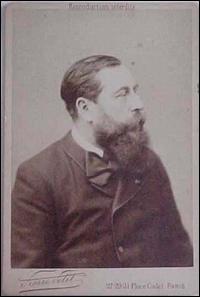| Works/Mp3 Biography Links Books Worklist | Biography ofLeo Delibes21 feb 1836 (St. Germain-du-Val) - 16 jan 1891(Paris) |
| Buy sheetmusic from Delibes at SheetMusicPlus |

Léo Delibes, cabinet card circa 1885.
Clément Philibert Léo Delibes (21 February 1836 – 16 January 1891) was a French composer of ballets, operas, and other works for the stage.
Biographical dataLéo Delibes was born in Saint-Germain-du-Val, now part of La Flèche (Sarthe), France, in 1836. His father was a mailman, his mother a talented amateur musician. His grandfather had been an opera singer. He was raised mainly by his mother and uncle following his father's early death. In 1871, at the age of 35, the composer married Léontine Estelle Denain. Delibes died 20 years later in 1891, and was buried in the Cimetière de Montmartre, Paris. His brother Michel Delibes migrated to Spain; he was the grandfather of Spanish writer Miguel Delibes. CareerStarting in 1847, Delibes studied composition at the Paris Conservatoire as a student of Adolphe Adam. A year later he began taking voice lessons, though he would end up a much better organ player than singer. He held positions as a rehearsal accompanist and chorus master at the Théâtre Lyrique, as second chorus master at the Paris Opéra (in 1864), and as organist at Saint-Pierre-de-Chaillot (1865–71). The first of his many operettas was Deux sous de charbon, ou Le suicide de Bigorneau ("Two sous-worth of coal"), written in 1856 for the Folies-Nouvelles. A ceremonial cantata, Algers, for Napoleon III on the theme of Algiers, brought him to official attention; a collaboration with Léon Minkus resulted, in which his contribution of an act's worth of musical numbers for a ballet La source (1866) brought him into the milieu of ballet. Delibes achieved true fame in 1870 with the success of his ballet Coppélia; its title referred to a mechanical dancing doll that distracts a village swain from his beloved and appears to come to life. His other ballet is Sylvia (1876). Delibes also composed various operas, the last of which, the lush orientalizing Lakmé (1883), contains, among many dazzling numbers, the famous coloratura showpiece known as the Légende du Paria or Bell Song ("Où va la jeune Indoue?") and The Flower Duet ("Sous le dôme épais"), a barcarolle that British Airways commercials made familiar to non-opera-goers in the 1990s. At the time, his operas impressed Tchaikovsky enough for the composer to rate Delibes more highly than Brahms—which seems faint praise when one considers that the Russian composer considered Brahms "a giftless bastard."[citation needed] In 1867 Delibes composed the divertissement Le jardin animé for a revival of the Joseph Mazilier/Adolphe Adam ballet Le corsaire. He wrote a mass, his Messe brève, and composed operettas almost yearly and occasional music for the theater, such as dances and antique airs for Victor Hugo's Le roi s'amuse, the play that Verdi turned into Rigoletto. Some musicologists believe that the ballet in Gounod's Faust was actually composed by Delibes. InfluenceDelibes' work is known to have been a great influence on composers such as Tchaikovsky, Saint-Saëns and Debussy. His ballet Sylvia was of special interest to Tchaikovsky, who wrote of Delibes' score,
WorksSee List of compositions by Léo Delibes and List of operas and operettas by Delibes. MediaReferences
External links | ||||
This article is licensed under the GNU Free Documentation License. It uses material from the Wikipedia article "Leo Delibes. Allthough most Wikipedia articles provide accurate information accuracy can not be guaranteed. |
| Buy sheetmusic from Delibes at SheetMusicPlus |
Help us with donations or by making music available!
©2023 Classic Cat - the classical music directory

Delibes, L.
Lakmé
Opéra-Comique Paris
Mozart, W.A.
Quintet for Clarinet & Strings
Soni Ventorum Wind Quintet
Beethoven, L. van
Symphony No. 4 in B flat major
Columbia Symphony Orchestra
Debussy, C.
2 arabesques
Tom Pascale
Bach, J.S.
Mass in B minor
Singakademie Tsukuba
Schubert, F.
Piano Sonata No. 21 in B flat D960
Seymour Lipkin


